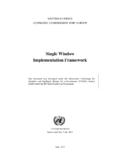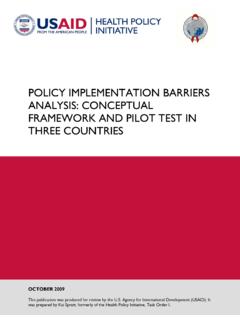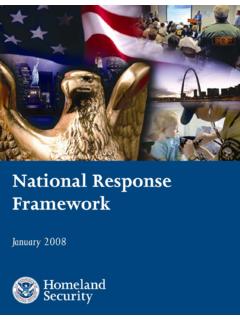Transcription of A FRAMEWORK FOR NATIONAL EALTH POLICIES …
1 A FRAMEWORK FOR NATIONAL HEALTH POLICIES , strategies AND PLANS June 2010 A FRAMEWORK FOR NATIONAL HEALTH POLICIES , strategies AND PLANS June 2010 This paper reviews current practice in and the potential for enhanced support to countries as they develop more robust, effective and credible NATIONAL health POLICIES , strategies and plans. 1. A renewed focus on Policy Dialogue around NATIONAL Health POLICIES , strategies and Plans Most countries have been using the development of NATIONAL Health POLICIES , strategies and Plans for decades to give direction and coherence to their efforts to improve health. WHO has a long track record of supporting countries in this endeavor: through technical cooperation and facilitation of NATIONAL policy dialogue and inter-country exchange, as well as through normative work and high level international policy frameworks. In many developing countries a diversity of agencies domestic as well as external is stepping up its support.
2 Yet, the renewed interest in these processes and instruments for steering country health sectors differs substantially from the 1980s and 1990s. There is a far greater recognition of challenges that require upstream policy responses rather than mere technical fixes: The mismatch between the actual performance of fragmented health systems and the rising expectations of society is becoming a cause of concern and internal pressure for health authorities as well as for politicians. This translates in growing calls for strengthening of health systems and a renewal of PHC: universal coverage, people centered care, emphasis on public health and health in all POLICIES . Governments recognize that they have the responsibility to translate these calls into NATIONAL health POLICIES , strategies and plans. At the same time, they recognize that in their pluralist, mixed health systems NATIONAL health POLICIES , strategies and plans have to address the problems of the entire health sector and cannot be limited to command-and-control plans for the public sector; It is now widely understood that NATIONAL health POLICIES , strategies and plans have to go beyond health care delivery and address the broad public health agenda; and that they have to go beyond the boundaries of health systems, addressing the social determinants of health and the interaction between the health sector and other sectors in society.
3 Many countries, however, struggle to develop the policy instruments to implement this. The current context is favorable for getting more value from NATIONAL health POLICIES , strategies and plans. Domestic expenditure on health grows (in many low- and middle-income countries this contrasts with the 1990s) which creates new challenges but also new opportunities, and the global information-society is modernizing and transforming the health sector across the world. There is much more emphasis on accountability of the many stakeholders in health; There is a growing expectation that NATIONAL health POLICIES , strategies and plans be informed by a realistic assessment of current capacities and a bold vision of the future; In an environment of global health governance, NATIONAL capacities and sustainable POLICIES , strategies and plans are a must to reap the full benefits of global cooperation and intelligence, while retaining country autonomy and specificity.
4 Finally, in countries where external aid plays a significant role, NATIONAL health POLICIES , strategies and plans are increasingly seen as the key to improve aid effectiveness. Both countries and aid agencies now consider strong NATIONAL health policy and planning processes to be critical for the harmonization and alignment of external and internal financial and technical inputs to the health sector and for addressing the unproductive fragmentation and duplication that is so common. 22. POLICIES , strategies and Plans: hierarchy, terminology and common disconnects POLICIES , strategies and plans are words that cover a wide spectrum of dimensions and hierarchies. They range from: From values and vision, policy direction, strategy, and strategic planning, to detailed operational planning; From comprehensive health planning to disease-specific or programme planning; From a long term, 10-20 year time horizon, to the 5 year plan , the 3 year rolling plan , and the yearly operational plan ; From NATIONAL to regional or district plans; From highest level endorsement of the vision and the policy directions, to approval of operational plans.
5 It is then not surprising that even a cursory glance at actual country processes and at the literature reveals an interchangeable use of the terms such as policy, plan , strategy and program. There seems to be not only a lack of consistency but also a lack of consensus on the way core terms are used. Such differential use reflects a diversity of approaches and levels at which NATIONAL health policy is undertaken, as well as the different aims countries have. In some countries work with a comprehensive NATIONAL Health plan that incorporates the notions of vision, policy, strategy, and plan . Others partition the products of the NATIONAL policy dialogue process in different ways, including the following: policy (covering the vision and broad policy directions) versus strategy (a strategic plan for implementation and operational plan and budget); NATIONAL strategic plan (merging vision, policy, strategy and plan ) versus operational plans ; NATIONAL health policy (situation analysis, values, policy directions) versus NATIONAL health strategic plan (implementation frame for the NATIONAL health policy); strategic plan (stewardship for the long term vision) versus operational plans (managerial, short term implications), and a bridge between these two, the medium term plan .
6 In any given country the partitioning between different products and the terminology used are largely determined by regional and NATIONAL specificities, by the political culture and history, and by the concrete challenges faced. This inter-country and inter-regional diversity in terminology and in practice has to be acknowledged. Still, it remains useful to map each individual country practice, by mapping it to a benchmark of hierarchies and terminologies, as illustrated in annex 1. This makes it easier to identify and correct common disconnects: Upstream, the frequent disconnect between the NATIONAL health policy/strategy/ plan and o the priorities and frameworks of global players, development agencies and donors; o the broader NATIONAL development POLICIES , policy frameworks and fiscal space; Downstream, the frequent disconnect between the overarching NATIONAL health policy/strategy/ plan and o the disease-specific or programme-specific strategies and plans (such as, for example, those targeted by the NATIONAL Strategy Applications of the GFTAM); o the sub- NATIONAL and decentralized planning processes, particularly the district operational plans.
7 33. Elements of good practice Experience shows that the policy dialogue for building comprehensive NATIONAL health POLICIES , strategies and plans is as much a political process as a technical one. It requires attention for the inspirational side of defining vision and policy; it also requires attention for operational detail. The balance between vision, policy, strategic planning and attention for implementation varies considerably from country to country. Given the overarching importance of context, blueprint approaches are unlikely to be of much assistance. Nevertheless, there are ways of going about policy dialogue that are more likely to produce robust POLICIES , strategies and plans. a) Sound process There is ample experience that NATIONAL Health POLICIES , strategies and Plans are more robust and more likely to get implemented effectively if their development and negotiation is inclusive of all relevant stakeholders (social, technical, political), in and beyond the health sector.
8 Smart timing with country political and institutional cycles and broad stakeholder involvement are critical and require: i. Building consensus on the situation analysis. ii. Broad consultation processes, across government and inclusive of civil society, to formulate the goals, the values and the overall policy directions that will guide strategy building, planning and decision making. iii. The active management of the process leading to high level endorsement of these policy directions. iv. Broad consultation on priority setting and design of the POLICIES , strategies and plans. v. Setting up mechanisms for getting feedback on implementation and initiating corrective measures. vi. Alignment with broader frameworks such as NATIONAL development plans or poverty reduction strategies as well as supra- NATIONAL POLICIES , agreements and initiatives. vii. Measures to ensure and protect country ownership and institutional capacity in countries where external agencies play an important role.
9 B) Realism NATIONAL Health POLICIES , strategies and Plans are more likely to be implemented if: i. They are made by the people who will implement them; ii. They are compatible with the sector s capacities and resources and constraints, and chart out realistic ways of developing capacities and resources through mobilization of government and partners around sectoral priorities; iii. Their policy directions are anchored through political and legal commitments that ensure long term sustained efforts, iv. Their link strategic and operational planning with enough flexibility for adapting to unexpected developments in the economic, political and health environment; v. They address the concerns of the implementing and middle levels of the health sector; vi. They enjoy political commitment of health sector management and government as well as the buy-in of stakeholders with competing interests. c) A comprehensive, balanced and coherent content NATIONAL health POLICIES , strategies and plans must articulate, in a manner appropriate to country context and constraints, in a comprehensive, balanced and coherent fashion: i.
10 Vision, values, goals, targets and intersectoral policy alignment 4ii. A robust situation analysis, covering: a. Assessment of social determinants of health and health needs, including current and projected disease burdens and health challenges; b. Assessment of expectations, including current and projected demand for services as well as social expectations c. Assessment of health system performance and of performance gaps in responding to needs and expectations d. Assessment of the capacity of the health sector to respond to current and to anticipate future challenges e. Assessment of health system resources (human, physical, financial, informational) and of resource gaps in responding to needs and expectations f. Assessment of stakeholder positions (including, where appropriate, of external partners) iii. The possible scenarios and policy directions for (i) improving health equity, (ii) making services people-centered so as to respond to priority needs and expectations,(iii) protecting and promoting the health of communities and public health; and (iv) building the capacity to deal with crisis and future challenges iv.
















